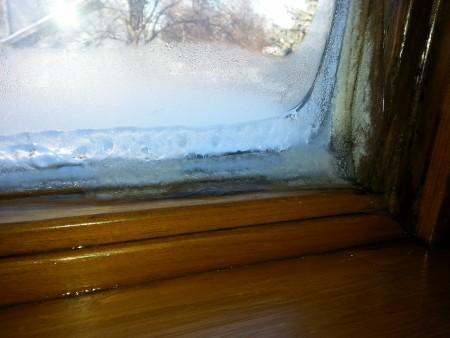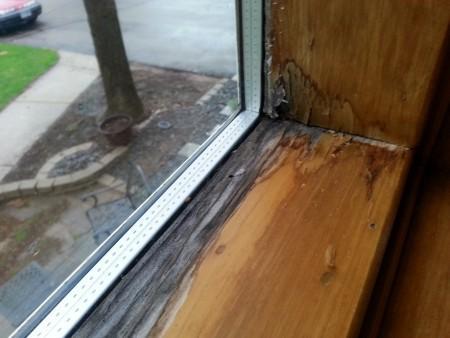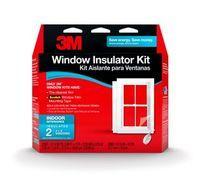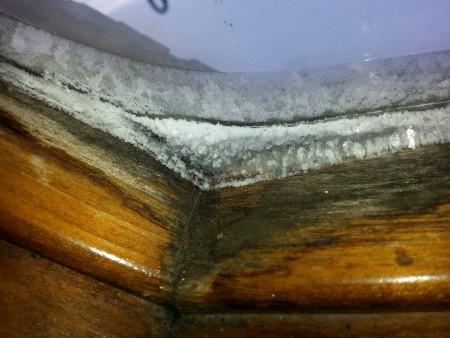This is a guest blog post by Ryan Carey, of My 3 Quotes.
Condensation can turn wood windows black and make a mess of window sills. It's a very common occurrence here in Minnesota. The typical

Studies show a typical family of 4 releases around 2.5 gallons of water per day into the air of their house. However, most of those families can't imagine cutting down on winter humidity levels when the house already seems bone dry. Your skin is cracking around the knuckles, lips are chapped, and giving your kid a kiss goodnight can cause a static spark so loud that it nearly gives the dog a heart attack. Yet there is still condensation on the windows? Why is this happening? In this post, we will talk about the causes and effects of window condensation, as well as strategies to prevent it from happening.
Why Does Condensation Happen?

OK, so here's the science of it: when the temperature of your glass drops below the dew point of the air inside your house, condensation starts to appear on your window glass. The dew point is the temperature at which the air is fully saturated with water vapor. Dew points in the 50's and lower 60's are pretty comfortable, but imagine how easy it is for the interior glass temperature to get well below that on a cold night in MN.
The bottom line is that there are only two variables to window condensation: indoor humidity and window temperature. To prevent condensation, these need to be controlled. Let's talk about how to do that.
Control humidity
Indoor humidity can be lowered by doing all of those things that I listed at the beginning of this post. Reuben listed a bunch of ways to lower indoor humidity levels in his blog post on siding stains, all of which apply to this situation. Here they are, word for word:
The most obvious "no-duh" thing would be to turn off your whole-house humidifier if you have one. A few other ways to lower indoor humidity levels are:
- Install timers on your bathroom exhaust fans that will run the fans for an hour at a time, and use the fans.
- Install bathroom exhaust fans in bathrooms that are used for showers or bathing if not present.
- If the kitchen hood fan exhausts to the exterior, use it while cooking.
- If you have too many plants (or weeds) in your home, fix that.
- If you have a crawl space with no vapor barrier, fix that. Crawl spaces with dirt floors are major contributors to indoor humidity.
- If your home doesn't have a ventilation strategy, add one. To understand what that means, please read this excellent article by Allison Bailes at the Journal of Light Construction web site: Choosing a Whole House Ventilation Strategy.
- Read the article linked to above. Seriously. This will make the rest of this blog post make more sense.
To monitor indoor humidity levels, buy an indoor humidity monitor and put it in the upper level of your home. Unfortunately, keeping indoor humidity levels low enough to completely avoid condensation at windows can lead to a very uncomfortable home. There are charts that have easy recommendations for avoiding condensation: 20 degrees outside? Lower house humidity to 40%. 0 degrees outside? Lower house humidity level to 30%. -20 degrees outside? Lower house humidity level to 15%! The Mojave Desert has a daytime humidity level that ranges from 10%-30%. Doesn't that sound comfortable? Absolutely, if you're a gecko.

Control window temperature
To help keep your windows warmer during the winter, don't close your blinds all the way to the bottom at night; you need warm air to wash over the windows to help keep them at a reasonable temperature. During the day, keep the blinds open. Even taking the screens off of crank-out windows helps a little to allow heat to reach the glass. That's about all you can do to keep the interior surface of your windows warmer, short of replacing them.
Other strategies

If you don't like any of these ideas, consider replacement windows. If your home was built in the 70's, 80's, or 90's, you may have the unfortunate combination of a tightly sealed house and double-pane pine windows with aluminum spacers between the two panes of glass. If you've read the rest of my window series, you know how I feel about aluminum spacers and real wood windows. The aluminum spacer that runs along the perimeter of the glass conducts the cold from the outside pane to the inside pane, making the glass surface even colder. Since none of the double pane windows from that era had new glass technology like Low E coating and argon gas available, the aluminum spacer gets nearly as cold as the outside temperature which causes more condensation (and sometimes freezing) on the inside piece of glass. The condensation forms on the coldest part of the glass, which tends to be the bottom edge where it meets the wood. Bottom corners are the coldest, with aluminum spacers meeting and helping to create the condensation "smile" that lifts up higher at those corners.

Even if you use real wood again on the interior, today's glass packs with multiple layers of Low E coating and argon gas are more effective and keep the inside glass at a higher temperature, resulting in less condensation and lower energy costs. Regardless, no window can completely eliminate condensation, so I encourage customers to go vinyl, composite, or fiberglass on the interior when getting new windows since those won't be hurt by water. Any spot where glass meets soft pine makes me nervous about maintenance issues, even with today's glass. That is also why non-wood windows have longer warranties than their real wood counterparts.
Some people may choose wood if they didn't have a previous condensation problem with the old windows. However, I've seen times when homeowners get condensation for the first time with new windows because the old windows were so drafty. The new windows are better at trapping air, which means less air changes per hour, which means a more humid house and a new problem. New houses are built so tight that they often have condensation on the windows, and the construction process can add to that when the newer studs and other wood components temporarily release moisture into the air.
Conclusion
The good news for those of you with the deteriorating wood windows is that you can minimize the damage by controlling humidity and following these tips. The bad news is many people don't want to follow those tips, myself included. Some people want to close their blinds, use humidifiers for the kids, and keep their house at a humidity level that doesn't cause their skin to crack. If you are one of those people, your wood windows are probably turning black. Staying on top of it year to year with sanding and re-varnishing the area where the glass meets the wood can certainly help. People have also bleached them at times to get some of the mold out. In the end, it depends on your own threshold for humidity levels, and whether or not you can continue on with the wood windows or get them replaced with something more moisture-friendly.
Author: Ryan Carey, My Three Quotes

